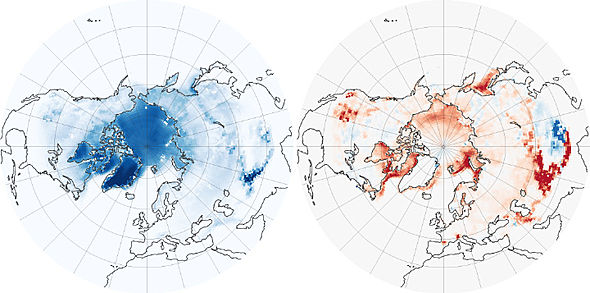
reflectance of northern hemisphere between 1979
and 2008, (b) net change in reflectance of the
northern hemisphere in the same time period from
melting sea ice, land ice and snow
(Flanner et al., 2011).
Cryospheric models incorporate the physics and chemistry of the natural environment into sets of equations in an attempt to represent and simulate reality. This allows for investigation of the cryosphere and forecasting of future outcomes. Changes to the cryosphere are expected to have a large impact on future climate over the polar regions and the rest of the globe, and vice versa (Figure 1). Computer models help humans understand the interrelated cryospheric and climatic changes which have already occurred and are projected for the future. As climate models become more sophisticated, they increasingly incorporate snow, ice, and frozen ground and thus are able to provide more accurate and useful information on the cryosphere and its interactions with the rest of the planet (IPCC, 2013).

One of the most significant factors in cryospheric terrestrial climate change is ice sheet dynamics. Models predict ice sheet movement, thickness, extent, melt and formation. Glaciers and ice streams are not currently incorporated into cryospheric modeling although they may have extensive effects on the Arctic system. Moreover, snow cover is modeled extensively for the cryosphere, and is based on influences of latent heat, sensible heat, evaporation, temperature, albedo and land cover. In addition to cryospheric terrestrial surfaces, ocean dynamics are also considered. Notably, sea ice flux is modeling through ice thickness, extent, snow cover, albedo, salinity and velocity. Physical and thermodynamic movement of sea ice varies in each model and is currently being developed to increase accuracy. It is largely believed that the Arctic will be completely ice free in summer months by the end of the century.
While an ice-free Arctic may be a benefit if you wish to sail across the North Pole or through the Northwest Passage, it will likely result in profound changes to the climate of the Arctic. Open ocean acts as a continuous moisture source from which water can evaporate into the atmosphere. Once the moisture is in the atmosphere it can be transported over thousands of kilometres by prevailing winds, where it then falls back to the surface as rain or snow. There is increasing evidence from models and observational data that large reductions in Arctic sea ice could lead to widespread changes in cloudiness and precipitation patterns across northern Russia, Canada, and the United States. The possible future implications of such changes are only beginning to be understood (IPCC, 2013).

in the Northern Hemisphere (September) and Southern
Hemisphere (February). Actual observed sea ice extents
shown as red line. (IPCC, 2013)
Many cryospheric processes directly influence change in other regions of the planet. The crysophere is particularly sensitive to change due to amplification of temperature change and concentration of greenhouse gases. The lack of in-situ climatic observations in the Arctic reduces the precision of model predictions. Many feedback loops and system threshold are unknown and modeling results are highly variable. However, an amplification of climate change sensitivity in the cryosphere is unquestionable.
The most recent climate model (CMIP5) utilized in IPCC 2013 has moderately improved from earlier versions (CMIP3). CMIP5 has been evaluated using process-based analysis, which reduces biases and corrects for short observational data. Figure 2 displays simulations of 40 CMIP5 climate models of September (Northern Hemisphere) and February (Southern Hemisphere) sea ice distribution. The multi-model mean error fits relatively well with observational data.
References
Climate Modelling Links
Material for this page was provided by Professor Christopher Fletcher, Assistant Professor, Core Member of IC3, Maren Pauly, and Tristan Mills, all Department of Geography and Environmental Management, University of Waterloo.
